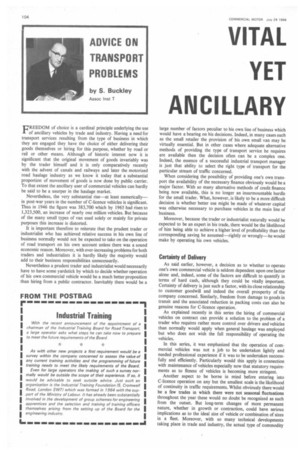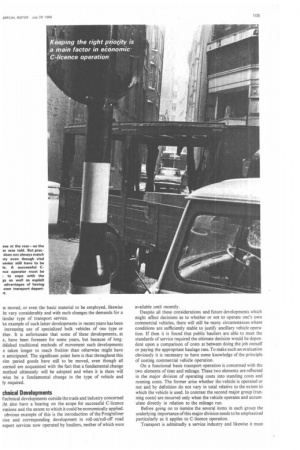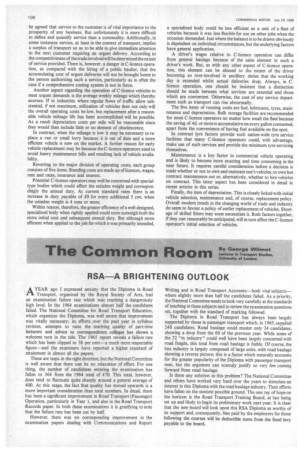• VITAL YET ANCILLARY
Page 106

Page 107

Page 108

If you've noticed an error in this article please click here to report it so we can fix it.
vREEDOM of choice is a cardinal principle underlying the use
of ancillary vehicles by trade and industry. Having a need for transport services resulting from the type of business in which they are engaged they have the choice of either delivering their goods themselves or hiring for this purpose, whether by road or rail or other means. Although of historic interest now it is significant that the original movement of goods invariably was by the trader himself and it is only comparatively recently with the advent of canals and railways and later the motorized road haulage industry as we know it today that a substantial proportion of movement of goods is now done by public carrier. To that extent the ancillary user of commercial vehicles can hardly be said to be a usurper in the haulage market.
Nevertheless, the very substantial rise—at least numerically— in post-war years in the number of C-licence vehicles is significant. Thus in 1946 the figure was 383,700 which by 1965 had risen to 1,323,500, an increase of nearly one million vehicles. But because of the many small types of van used solely or mainly for private purposes this increase is distorted.
It is important therefore to reiterate that the prudent trader or industrialist who has achieved relative success in his own line of business normally would not be expected to take on the operation of road transport on his own account unless there was a sound economic reason. Moreover, with ever-increasing problems for both traders and industrialists it is hardly likely the majority would add to their business responsibilities unnecessarily.
Nevertheless a prudent trader and industrialist would necessarily have to have some yardstick by which to decide whether operation of his own commercial vehicle would be a much better proposition than hiring from a public contractor. Inevitably there would be a
large number of factors peculiar to his own line of business which would have a bearing on his decisions. Indeed, in many cases such as the small retailer the provision of his own small van may be virtually essential. But in other cases where adequate alternative methods of providing the type of transport service he requires are available then the decision often can be a complex one. Indeed, the essence of a successful industrial transport manager is just that ability to select the right type of transport for the particular stream of traffic concerned.
When considering the possibility of providing one's own transport the availability of the necessary finance obviously would be a major factor. With so many alternative methods of credit finance being now available, this is no longer an insurmountable hurdle for the small trader. What, however, is likely to be a more difficult decision is whether better use might be made of whatever capital was otherwise necessary to purchase vehicles in the main line of business.
Moreover, because the trader or industrialist naturally would be expected to be an expert in his trade, there would be the likelihood of him being able to achieve a higher level of profitability than the corresponding saving he assumed—rightly or wrongly—he would make by operating his own vehicles.
Certainty of Delivery
As said earlier, however, a decision as to whether to operate one's own commercial vehicle is seldom dependent upon one factor alone and, indeed, some of the factors are difficult to quantify in terms of hard cash, although they could be vitally important. Certainty of delivery is just such a factor, with its close relationship to customer goodwill and indeed the overall prosperity of the company concerned. Similarly, freedom from damage to goods in transit and the associated reduction in packing costs can also be genuine reasons for C-licence operation.
As explained recently in this series the hiring of commercial vehicles on contract can provide a solution to the problem of a trader who requires rather more control over drivers and vehicles than normally would apply when general haulage was employed but who does not wish the full responsibility of operating the vehicles.
In this series, it was emphasized that the operation of commercial vehicles was not a job to be undertaken lightly and needed professional experience if it was to be undertaken successfully and efficiently. Particularly would this apply in connection with maintenance of vehicles especially now that statutory requirements as to fitness of vehicles is becoming more stringent_ Another aspect to be borne in mind before entering into C-licence operation on any but the smallest scale is the likelihood of continuity in traffic requirements. Whilst obviously there would be a few trades in which there were not seasonal fluctuations throughout the year these would no doubt be recognized as such from the outset. But long-term changes of more permanent nature, whether in growth or contraction, could have serious implications as to the ideal size of vehicle or combination of sizes in a fleet. Moreover, with so many technical developments taking place in trade and industry, the actual type of commodity x moved, or even the basic material to be employed, likewise ht vary considerably and with such changes the demands for a ticular type of transport service.
kn example of such latter developments in recent years has been increasing use of specialized bulk vehicles of one type or ,ther. It is unfortunate that some of these developments, at .t, have been foreseen for some years, but because of longiblished traditional methods of movement such developments e taken longer to reach fruition than otherwise might have n anticipated. The significant point here is that throughout this rim period goods have still to be moved, even though all cerned are acquainted with the fact that a fundamental change method ultimately will be adopted and when it is there will wise be a fundamental change in the type of vehicle and ly required.
chnical Developments
Technical developments outside the trade and industry concerned ;ht also have a bearing on the scope for successful C-licence ;rations and the extent to which it could be economically applied. obvious example of this is the introduction of the Freightliner vice and corresponding development in roll-on/roll-off road nsport services now operated by hauliers, neither of which were available until recently.
Despite all these considerations and future developments which might affect decisions as to whether or not to operate one's own commercial vehicles, there will still be many circumstances where conditions are sufficiently stable to justify ancillary vehicle operation. If then it is found that public hauliers are able to meet the standards of service required the ultimate decision would be dependent upon a comparison of costs at between doing the job oneself or paying the appropriate haulage rate. To make such an evaluation obviously it is necessary to have some knowledge of the principle of costing commercial vehicle operation.
On a functional basis transport operation is concerned with the two elements of time and mileage. These two elements are reflected in the major division of operating costs into standing costs and running costs. The former arise whether the vehicle is operated or not and by definition do not vary in total relative to the extent to which the vehicle is used. In contrast the second major group (running costs) are incurred only when the vehicle operates and accumulate directly in relation to the mileage run.
Before going on to itemize the several items in each group the underlying importance of this major division needs to be emphasized particularly as it applies to C-licence operation.
Transport is admittedly a service industry and likewise it must be agreed that service to the customer is of vital importance to the prosperity of any business. But unfortunately it is more difficult to define and quantify service than a commodity. Additionally, in some instances service, at least in the context of transport, implies a surplus of transport so as to be able to give immediate attention to the next customer requiring an urgent delivery. According to the competitiveness of the trade involved will be determined the extent of service provided. There is, however, a danger in C-licence operation, as compared with the hiring of a public haulier, that the accumulating cost of urgent deliveries will not be brought home to the person authorizing such a service, particularly as is often the case if a comprehensive costing system is not in force.
Another aspect regarding the operation of C-licence vehicles to meet urgent demands is the average weekly mileage which thereby accrues. If in industries where regular flows of traffic allow substantial, if not maximum, utilization of vehicles then not only will the overall operating costs be low, but replacement after a reasonable vehicle mileage life has been accomplished will be possible. As a result depreciation costs per mile will be reasonable since they would then include little or no element of obsolescence.
In contrast, when the mileage is low it may be necessary to replace a van or small lorry because it is out of date and a more efficient vehicle is now on the market. A further reason for early vehicle replacement may be because the C-licence operators need to avoid heavy maintenance bills and resulting lack of vehicle availability.
Reverting to the major division of operating costs, each group consists of five items. Standing costs are made up of licences, wages, rent and rates, insurance and interest.
Potential C-licence operators may well be concerned with specialtype bodies which could affect the unladen weight and correspondingly the annual duty. At current standard rates there is an increase in duty payable of 19 for every additional 5 cwt. when the unladen weight is 4 tons or more.
Within reason, therefore, the greater efficiency of a well-designed. specialized body when rightly applied could soon outweigh both the extra initial cost and subsequent annual duty. But although more efficient when applied to the job for which it was primarily intended, a specialized body could be less efficient as a unit of a fleet of vehicles because it was less flexible for use on other jobs when the occasion demanded. Just where the balance is to be drawn obviously is dependent on individual circumstances, but the underlying factors have general application.
A driver's wages relative to C-licence operation can differ from general haulage because of the sales element in such a driver's work. But, as with any other aspect of C-licence operation, this element can be abused to the extent of the driver becoming so over-involved in ancillary duties that the working day is extended whilst actual deliveries drop. Always, in Clicence operation, one should he insistent that a distinction should be made between what services are essential and those which are convenient. Otherwise, the cost of any service department such as transport can rise abnormally.
The five items of running costs are fuel, lubricants. tyres, maintenance and depreciation. Bulk storage facilities are recommended for most C-licence operators no matter how small the fleet because the saving of 4d. or more is accumulative on every gallon consumed, apart from the convenience of having fuel available on the spot.
In contrast tyre factors provide such nation-wide tyre service facilities that many C-licence operators could, with advantage, make use of such services and provide the minimum tyre servicing themselves.
Maintenance is a key factor in commercial vehicle operating and is likely to become more exacting and time consuming in the near future. It requires careful consideration before a decision is made whether or not to own and maintain one's vehicles, to own but contract maintenance out or, alternatively, whether to hire vehicles on contract. This latter aspect has been considered in detail in recent articles in this series.
Finally, the item of depreciation. This is closely linked with initial vehicle selection, maintenance and, of course, replacement policy. Overall modern trends in the changing world of trade and industry do seem to favour a policy of earlier replacement of vehicles. Shortage of skilled fitters may soon necessitate it. Both factors together, if they can reasonably be anticipated, will in turn affect the C-licence operator's initial selection of vehicles.
































































































































































